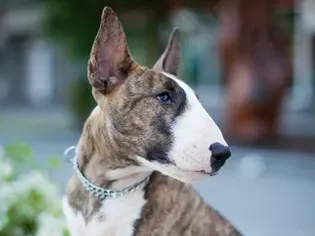Bull Terrier: Dog Breed Characteristics & Care
Updated on 05/26/24

Bull Terrier: The Enigmatic and Endearing Canine Companion
Introduction
Welcome to a comprehensive guide to the captivating Bull Terrier, a distinctive breed that exudes both strength and charm. Join us as we delve into the remarkable characteristics, unique care requirements, and fascinating history of these captivating canines.
Historical Origins and Lineage
The Bull Terrier's lineage traces back to the mid-19th century, a time when crossbreeding Mastiffs, Bulldogs, and Terriers created a fierce and formidable fighting breed. However, through selective breeding, the Bull Terrier evolved into the more refined and affectionate companion we know today.
Physical Characteristics and Distinctive Features
1. Egg-Shaped Head: The Bull Terrier's most striking feature is its egg-shaped head, a unique and unmistakable silhouette.
2. Short, Glossy Coat: Its coat is short, flat, and glossy, typically white, brindle, or colored. White Bull Terriers often have a black, reddish-brown, or brindle "mask" on their faces.
3. Muscular Build: Despite its medium size, the Bull Terrier boasts a muscular and agile build, with a powerful chest and strong, well-proportioned limbs.
4. Undershot Bite: The Bull Terrier's characteristic undershot bite, where the lower teeth protrude past the upper teeth, is a testament to its fighting past.
Temperament and Personality
1. Affectionate and Loyal: Bull Terriers are surprisingly affectionate and loyal, forming strong bonds with their families. They thrive on human companionship and crave attention.
2. Playful and Energetic: These dogs are known for their playful and energetic nature, always ready to engage in games and activities. Their playful antics will undoubtedly bring joy to your household.
3. The "Clown of the Dog World": Bull Terriers have earned the nickname "the clown of the dog world" for their silly and unpredictable behavior. They are known for their antics and love to make their humans laugh.
4. Courageous and Tenacious: Despite their affectionate nature, Bull Terriers retain a natural instinct for courage and tenacity. They are fearless and protective of their loved ones.
Care Considerations
1. Exercise and Activities: Bull Terriers require regular exercise and mental stimulation to maintain their physical and mental well-being. Daily walks, playtime in the park, and interactive games are essential for their happiness.
2. Training and Socialization: Consistent training and early socialization are crucial for Bull Terriers. They are intelligent dogs but can be stubborn at times. Patience and positive reinforcement are key to successful training.
3. Health Issues: Bull Terriers are generally healthy dogs, but like all breeds, they may be prone to certain health conditions. Hip dysplasia, heart issues, and deafness are some potential concerns to discuss with your veterinarian.
4. Diet and Nutrition: A balanced and nutritious diet is vital for the well-being of your Bull Terrier. Consult with your veterinarian to determine the appropriate dietary plan for your dog's age, weight, and activity level.
Conclusion
The Bull Terrier is a captivating and endearing canine companion that combines a unique appearance with an affectionate and playful personality. Their loyalty, courage, and ability to make you laugh make them a cherished addition to any family.
With proper care and attention, your Bull Terrier will thrive and bring immeasurable joy and companionship to your life. Embrace the enigmatic and charming nature of this extraordinary breed, and you will discover a loyal and loving friend for life.
Explore More Pets

Basic Training
Puppy and Baby Introductions

Working Dog Breeds
All About Search and Rescue Dogs

Dog Treatments
Puppy Vaginitis: Signs, Causes and Treatment

Dog Adoption
After More Than 1,200 Days in the Shelter, Coco Goes Home

Basic Training
How to Train Your Puppy to Go on Potty Pads

Hybrid Dog Breeds
The Difference Between a Mutt, Mixed Breed, or Designer Dog?

Dog Treatments
Nail Problems in Dogs

Puppies
7 Reasons Why Two Dogs Are Better Than One
